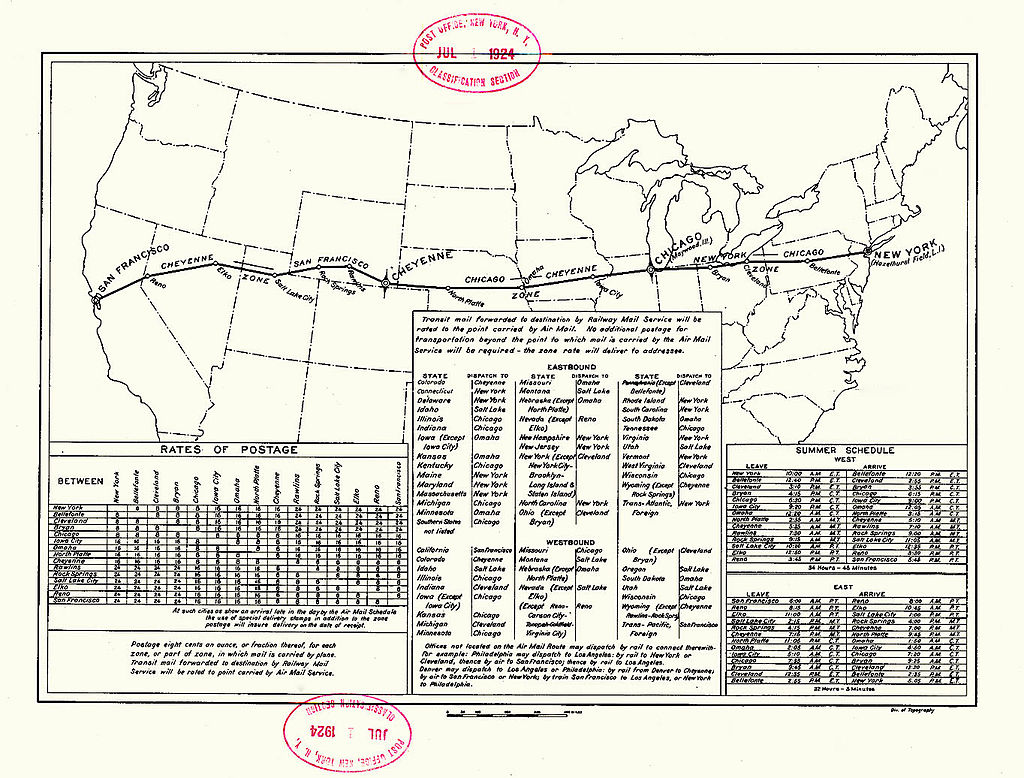A Concrete Solution
It’s the 1920s. The Wright Brothers took to flight only about two decades ago and air travel is still in its early stages. Rail is the predominant method of travel and transport across the United States, but the Postal Service is taking to the skies in hopes of getting mail across the nation. It’s called the Transcontinental Airmail Route. It runs from New York to San Francisco, as seen in the map below.

But there’s a big problem. There aren’t a lot of aviation maps yet, and besides, the instruments used by airlines aren’t all that great. Pilots tend to use visual cues — landmarks, natural or man-made — to figure out where they are and how to get to where they’re going. Makes sense.
Except that it doesn’t work all the time. Many of the areas these planes pass over are barren plains, nondescript hills, or the like, nearly impossible to tell apart from one another. So, what’s the Postal Service to do?
Arrows.
In this case, giant concrete ones pointing in the right direction, easily visible from the sky.
![]()
That’s what they look like from the ground, but from the air, they look something like this. (That’s pretty zoomed out because the image was taken by a satellite, not a plane, but you get the idea.) Jeopardy! champion Ken Jennings explained:
Every ten miles, pilots would pass a bright yellow concrete arrow. Each arrow would be surmounted by a 51-foot steel tower and lit by a million-candlepower rotating beacon. (A generator shed at the tail of each arrow powered the beacon.) Now mail could get from the Atlantic to the Pacific not in a matter of weeks, but in just 30 hours or so.
Congress first approved the funding for the flight path indicators in 1923, according to the Verge, and the next year, the first ones went up, starting in Ohio and extending to Wyoming. Before the decades was out, the entire route was mapped out on the ground, signaling to aviator-mailmen which way to go for more than a decade.
In the 1940s, however, advancements in technology made the concrete arrows obsolete and they began to fall into disrepair. The yellow paint faded over time and the steel towers were repurposed, with much of the steel used for the United States’ efforts in ramping up the military as the nation entered World War II. But the arrows themselves remain, despite being overcome in many places by weeds and time, pointing more toward history than toward the Pacific.
Bonus Fact: On August 8, 1988, the Chicago Cubs played their first home game at night (unofficially, as it was rained out). Wrigley Field, their long-standing home stadium, didn’t have lights, and was the last then-existing Major League stadium without them by decades. The reasons for the long delay were numerous, with local politicians eventually passing an ordinance preventing the installation (the cross-town White Sox, whose lights were from the late 1930s, were grandfathered in). But that wasn’t the original plan. The team intended to install lights before the 1942 season, but when the Japanese attacked Pearl Harbor in December of 1941, the steel used for the lights was instead used for the war effort.
From the Archives: Hidden Messages: The arrow that’s not exactly there.
Related: A decently-rated RC plane.
